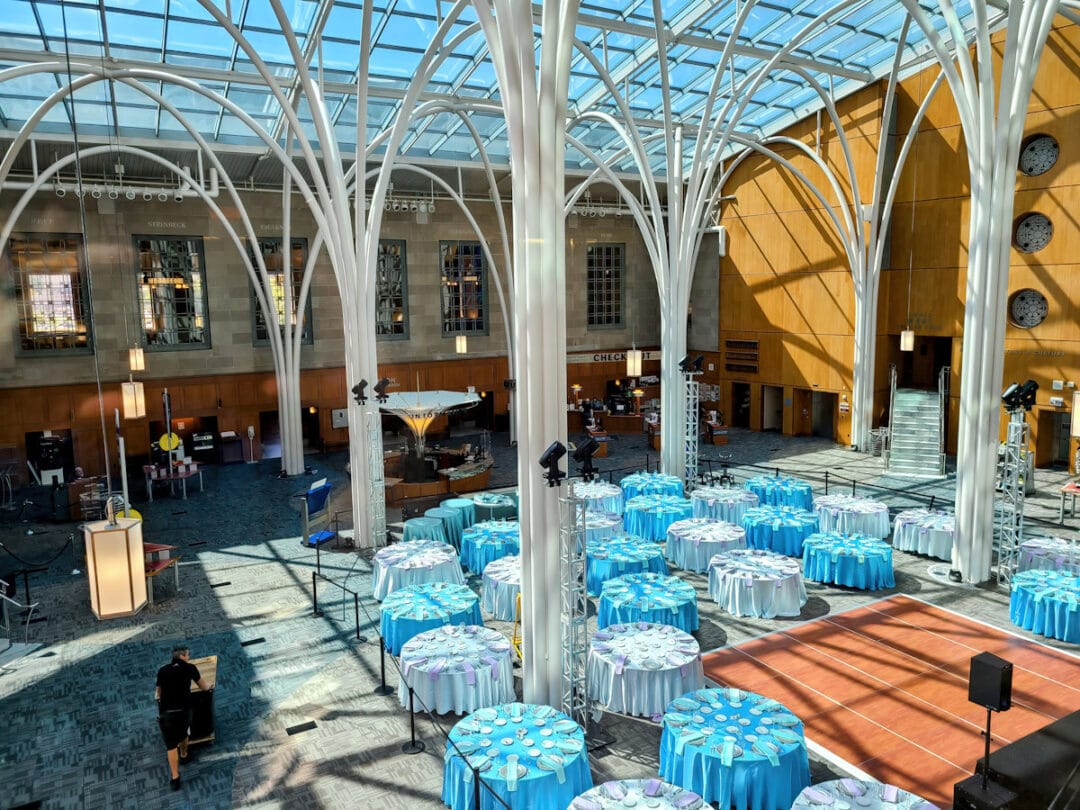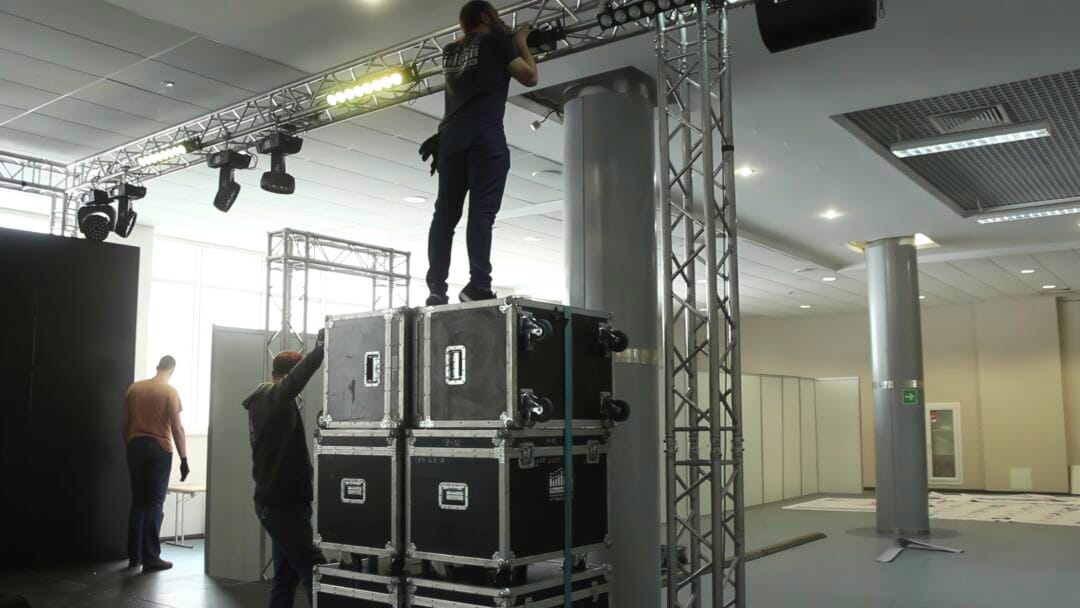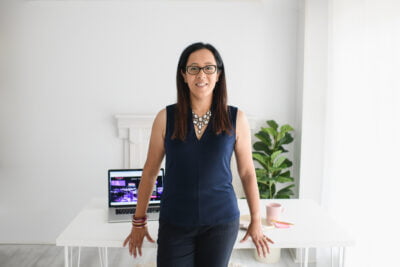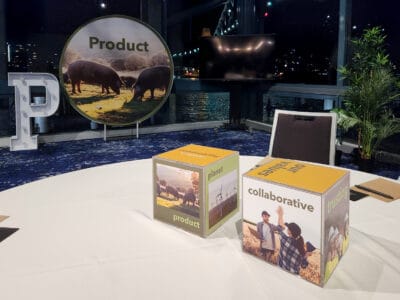The design of an event space can make or break the success of a corporate gathering. The environment fosters participant learning and connection, whether it’s a conference, workshop, or team-building session. Thoughtfully planned spaces enhance engagement and encourage collaboration, helping you achieve your event goals with greater impact.
But what separates a good event space from a great one? It’s all about intentional design – incorporating elements that cater to the needs of your audience while aligning with your objectives. In this blog, we’ll explore the importance of event space design, key features to focus on, and practical strategies for creating a dynamic and memorable experience.

Why Event Space Design Matters
The physical environment of an event influences how people engage, interact, and absorb information. A cramped, poorly lit room stifles creativity and collaboration, whereas an open, thoughtfully designed space promotes active participation.
Research shows that well-designed spaces can improve learning outcomes by up to 25%, thanks to factors like optimised layouts, access to natural light, and ergonomic furniture. For example, a spacious venue with movable furniture allows participants to transition seamlessly between group activities and individual tasks, reducing downtime and encouraging productivity.
Poorly designed spaces, on the other hand, can derail even the most carefully planned events. Picture a workshop where attendees are forced to huddle around insufficient seating or struggle to hear a speaker over poor acoustics. These frustrations detract from the event’s goals, leaving attendees disengaged and unmotivated.
Investing in purposeful design can set the tone for an event that energises and inspires your audience.
Key Elements of Learning-Focused Event Spaces
Layout and Accessibility
The layout of an event space plays a critical role in creating a conducive learning environment. Flexible arrangements like round tables or U-shaped setups promote open dialogue and collaboration. Spaces that allow for easy movement between areas also encourage natural interaction.
Consider adding dedicated zones for different purposes:
- Presentation Areas: Optimise seating arrangements to ensure clear sightlines for all attendees.
- Interactive Zones: Include areas with movable seating or standing desks for brainstorming sessions.
- Quiet Corners: Provide calm spaces for reflection or one-on-one discussions.
Accessibility is another crucial factor. Ensure the venue is easily navigable for all attendees, including those with mobility challenges. Ramps, elevators, and wide walkways make a space more inclusive and welcoming.
Technology Integration
Modern corporate events thrive on technology. Whether it’s a live-streamed panel discussion or an interactive workshop, the right tech can elevate your event to the next level.
Some must-have tech integrations include:
- Interactive Displays: Smartboards and touchscreens for real-time collaboration.
- Reliable Wi-Fi: Ensure strong connectivity for seamless virtual engagement.
- AV Equipment: High-quality microphones, projectors, and speakers for crystal-clear presentations.
- Charging Stations: Keep attendees’ devices powered throughout the day.
Hybrid events, in particular, benefit from robust tech setups catering to in-person and virtual participants. A well-equipped space ensures no one feels left out, regardless of how they’re attending.
Comfort and Aesthetics
Comfort is a non-negotiable element of any successful event space. Long sessions demand seating that provides adequate support, while temperature control ensures attendees remain focused.
Visual appeal also plays a vital role in setting the tone. Incorporate elements like:
- Greenery: Plants and flowers to create a fresh, inviting atmosphere.
- Lighting Design: A mix of natural and ambient lighting for different moods.
- Colour Schemes: Use colours that energise and inspire, such as blue for focus or yellow for creativity.

The Role of Lighting in Event Spaces
Lighting is one of the most versatile tools for setting the mood of an event. Bright, natural light boosts energy levels, improves focus, and even enhances mood, making it ideal for learning-focused events.
For example, a conference held in a venue with large windows and plenty of daylight creates a more stimulating environment than one in a dark, enclosed room. On the flip side, soft, dimmed lighting is perfect for networking sessions, where a relaxed ambiance encourages conversation.
Adjustable lighting systems allow you to adapt to various activities throughout the day. Breakout sessions may require bright task lighting, while keynote speeches benefit from a spotlight effect. By tailoring lighting to specific needs, you can create an environment that supports both learning and connection.
The Importance of Flexible Spaces
Corporate events often involve diverse activities, from panel discussions and workshops to networking sessions and breakout groups. Flexible spaces with movable furniture and modular layouts make adapting to these changing needs easier.
For example:
- Use retractable walls to divide a large hall into smaller rooms for workshops.
- Opt for stackable chairs and folding tables that can be rearranged quickly.
- Include open-plan spaces for impromptu networking or collaborative brainstorming.
Flexibility also means being prepared for last-minute changes. Whether it’s an unexpected increase in attendees or a shift in the schedule, a versatile space ensures your event runs smoothly.
Additionally, flexible spaces empower organisers to optimise attendee flow. For instance, strategically positioning interactive booths or activity zones can encourage movement and interaction, preventing bottlenecks. These spaces are particularly valuable for hybrid events, where digital setups must integrate seamlessly with in-person activities, ensuring inclusivity and engagement for all participants.
Personalisation in Event Space Design
Adding personal touches to your event space enhances attendee engagement and reinforces your brand identity. These elements, from custom banners to digital displays showcasing your logo, make your event feel cohesive and memorable.
Consider offering personalised attendee experiences, such as:
- Name-tag stations with a creative twist.
- Branded welcome packs featuring event materials.
- Themed décor aligned with your company’s mission or values.
Personalisation goes beyond visuals—it’s also about tailoring the event experience. Incorporate interactive features, such as live polls or Q&A sessions, that allow attendees to participate actively. You can also design networking opportunities based on attendee preferences or industries, making interactions more meaningful. When attendees feel that the event is crafted specifically for them, they’re more likely to leave with a positive and lasting impression.
Sustainability in Event Space Design
Sustainability is no longer just a trend—it’s an expectation. Attendees increasingly appreciate events that prioritise eco-conscious practices, making this an excellent opportunity to showcase your company’s environmental commitment.
Here are some ways to incorporate sustainability:
- Venue Selection: Choose venues that use renewable energy or implement green initiatives.
- Eco-Friendly Décor: Opt for reusable or biodegradable materials.
- Waste Reduction: Use digital event materials and provide recycling stations.
- Sustainable Catering: Work with suppliers focusing on local, seasonal, and organic ingredients.
In addition to these steps, consider introducing carbon offset initiatives. Collaborate with venues and event partners to offset the environmental impact of transportation and energy usage, such as by planting trees or donating to green projects. Providing attendees with reusable items, like water bottles or tote bags, further minimises waste while serving as a lasting reminder of the event’s commitment to sustainability. These efforts reduce your event’s environmental footprint and resonate with attendees who value ethical and eco-conscious practices.
Designing for Connection and Collaboration
Networking-Friendly Zones
Networking is often a top priority for corporate events. Create areas where attendees can mingle comfortably, such as:
- Casual lounges with sofas or armchairs.
- Standing tables near refreshment stations.
- Outdoor patios for informal conversations.
Including conversation prompts or icebreaker activities in these areas can also encourage meaningful interactions.
Seating Arrangements
The way you organise seating can significantly impact group dynamics. For instance:
- Circular Layouts: Encourage open dialogue and collaboration.
- Clusters: Ideal for brainstorming and teamwork.
- Traditional Rows: Best for keynote presentations.
Adjusting seating arrangements to fit the session’s purpose helps attendees stay engaged and focused.
Breakout Areas
Breakout areas are invaluable for fostering smaller group discussions or individual reflection. To encourage creativity, equip these spaces with tools like whiteboards, flip charts, and tablets.
Planning for Success: Corporate Event Strategies
Every successful corporate event begins with clear objectives. What do you want attendees to take away? Once your goals are defined, align the event space design to achieve those outcomes.
Collaborating with professional event planners, such as Pink Caviar Events, ensures every detail is covered. From selecting the right venue to incorporating tech and décor, their expertise can turn your vision into reality while saving you time and stress.
Effective planning also involves anticipating challenges and preparing contingency plans. For example, having a backup venue or alternate activities in case of unexpected disruptions like weather changes or technical failures can ensure the event proceeds smoothly. Additionally, creating a detailed event timeline and assigning roles to team members allows for seamless execution, ensuring that no detail is overlooked and attendees have a memorable and stress-free experience.
Conclusion
A well-designed event space is more than just a backdrop – it’s a catalyst for learning, connection, and inspiration. By focusing on layout, lighting, flexibility, and sustainability, you can create an environment that supports your goals and leaves a lasting impression on attendees.
Ready to elevate your next corporate event? Contact Pink Caviar Events at 1300 884 800 or info@pinkcaviar.com.au for seamless, stress-free planning.
Dimitri Cassimatis is the Marketing Manager at Pink Caviar Events, a Sydney-based corporate event management and styling company. With over 20 years of experience across marketing, communications, and creative strategy, Dimitri combines brand insight with advanced technology to deliver impactful, results-driven campaigns. His expertise spans digital marketing, branding, SEO, and automation, with a strong focus on high-end tech solutions, including AR, VR, AI integration, and digital infrastructure design. Passionate about innovation, Dimitri leverages emerging technologies to enhance audience engagement and drive growth across Pink Caviar’s corporate portfolio.




